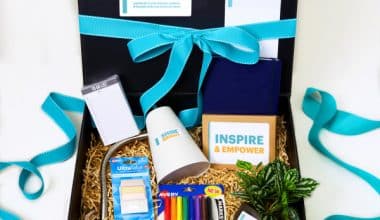WHAT IS A BLOG?
A blog website is an informational website that displays posts or articles written by individuals or groups in reverse chronological order, with the most recent posts appearing first and at the top. It is a forum in which a writer or group of writers can express their opinions on a specific topic.
Jorn Barger coined the term “weblog” in 1997, describing his process of logging the web. In 1999, programmer Peter Merholz shortened it to “blog.” Today, there are over 500 million blogs on the web, with the number of bloggers in the USA set to reach 35 million users by 2024.
What Is A Blog Post?
A blog post is a standalone web page on your website that explores a specific blog subtopic. Consider the scenario where you launch a lifestyle blog on your online store. The Best Suit Combinations for 2023 might be the title of one blog post. The article addresses a very specific sub-topic while still connecting to your blog’s main topic.
Generally, blog posts enable businesses to rank on search engines for various keywords, allowing visitors to access your website and explore your clothing items. By linking back to your overall site, you can increase visibility and drive traffic to your website.
What Is Blog Writing?
Blog writing is the process of developing blog posts and posting them online. A person or business may own the website and post content that takes the form of articles, images, or other digital media. Lengthy articles on a particular topic are frequently shared as part of blogging.
What Does A Blog Look Like?
A blog consists of articles or posts, with appearances varying depending on platform and design choices. Common elements include:
#1. Header:
The title or logo of your blog is frequently found in the top section of a blog, along with a menu that directs readers to different parts or categories of your blog. For recurring readers who are specifically looking for articles on that specific topic, you may choose to group blogs on the same subject together.
#2. Content body:
The content body is where your blog post’s content is shown. Each post typically contains a title, author name, publication date, and the post’s primary content, which may be text, videos, images, or other types of media.
#3. Sidebar:
A blog’s sidebar, located on either side of the main content area, offers additional features like the search bar, recent posts, popular posts, categories, tags, social media links, an about section, and advertisements, establishing navigation and site hierarchy for users and search engines.
#4. Comments:
On many blogs, readers are welcome to comment on individual posts. Readers may be able to reply to comments or like them in the comments section, which usually appears below the post’s body of text. Ensure you have the necessary resources and time to effectively manage comments before enabling them on your blog.
Therefore, you’ll need to keep an eye on them for spam that needs to be removed or messages from real readers you have to connect with.
#5. Footer:
The footer contains copyright disclosures, links to your privacy and terms of service, additional navigation links, and occasionally widgets like a subscription form, social media icons, or related posts that are typically found in the bottom section of your blog.
Overall, depending on the theme, options for customization, and personal preferences you select, blog designs could differ considerably. These components give a general idea of how a blog appears, but blogs may have particular layouts or extra features depending on the platform you choose and your design preferences.
Types Of Blogs
Blogs feature individual posts on various topics, including food, fashion, and marketing. Additionally, with lively comment sections, microblogging is a well-liked social media platform for discussions. Therefore, similar to a newspaper, a blog compiles articles and keeps an archive.
You’ve probably come across blogs all over the internet, whether they were standalone blogs or parts of larger websites. In the blogosphere, a few of the most popular blog categories are:
- Food blogs
- Travel blogs
- Health and fitness blogs
- Lifestyle blogs
- Fashion and beauty blogs
- Parenting blogs
- Business blogs
- Sports blogs
- Art blogs
Examples Of Blogs
#1. Digital Agency Blog:
Your company can get assistance and counsel from accredited consultants and agencies by reading digital agency blogs. The following blogs are written by service providers from around the world who assist companies with implementing effective inbound and digital strategies.
#2. Education and Nonprofit Blogs:
Teachers, principals, volunteer groups, and leaders have a means of learning about each other’s findings and tactics through education and nonprofit blogs. Most importantly, they offer these individuals the chance to work together and exchange knowledge to advance each other.
#3. Technology Blogs
It’s no secret that technology is constantly changing. Therefore, businesses must make every effort to stay abreast of the cutting-edge advancements that affect their capacity to expand and reach the right audience because there are so many developments being made every day.
#4. E-commerce Blogs:
E-commerce blogs assist online retailers of all stripes in learning more about the latest tech, trends, and tools available in the market to help them expand and accomplish their short- and long-term objectives. Additionally, these blogs discuss e-commerce marketing, online store development, and other topics.
#5. Healthcare Blogs:
Healthcare blogs are available to help organizations and people stay up to date on the most significant and recent advancements in the field, whether they pertain to law, policy, treatment, technology, or research.
#6. Manufacturing Blogs:
Manufacturing blogs are used to enlighten people in the industry about news, trends, and best practices. This includes supply chain, distribution, and logistics. Therefore, such blogs keep you informed and knowledgeable about this rapidly evolving business world.
#7. Marketing Blogs:
Social media, inbound marketing, content creation, and organic growth are just a few of the many topics that marketing blogs address. To assist you in creating a marketing plan that is unique to your company, they may concentrate on a single area of marketing or discuss general industry trends.
What Is The Purpose Of A Blog?
A blog serves the purpose of making your brand’s website more interesting and engaging. Therefore, you may feature a blog section on your website in addition to using it to inform visitors about your goods and services and relevant industry topics.
Additionally, a blog can also aid in increasing search engine traffic to your website. More people will be able to discover your blog content through searches and perhaps even the rest of your website if you use pertinent keywords.
What Are The 4 Common Types Of Blogs?
Choose the right blog based on your target audience and goals, with examples of common types.
#1. Personal Blogs
Personal bloggers are torchbearers in the blogging industry, offering first-person accounts of their ideas, perceptions, and experiences. Aiming to inspire and connect with readers, they frequently have a distinctive perspective on issues like mental or chronic disease, single motherhood, or life obstacles. Additionally, a personal blog can be rewarding for those with a distinctive viewpoint and a compelling message.
#2. Business Blogs
A business blog, or corporate blog, promotes a business rather than an individual, with less personal content. It frequently includes educational articles to assist readers in problem-solving and draw in new customers, like “3 Simple Ways to Weed Your Garden.”
Writing helpful articles and blogging about your company are great ways to increase traffic to your website because search engines like Google reward blogs that consistently provide relevant information.
#3. Affiliate Blogs
Affiliate blogs are profitable niche-specific blogs where bloggers sell goods and services, earning commissions for each sale. They write product reviews, and tutorials, and add affiliate links to their posts. To succeed, bloggers must position themselves as experts and build trust with their readers, ensuring their products add value to their lives.
#4. Niche Blogs
A niche blog is a type of blog that covers a specific topic, such as health, crafting, sports, or parenting. To monetize a niche blog, it’s essential to understand the audience and offer valuable products or services, such as ebooks or coaching, that they will find valuable.
How do you start a blog?
#1. List your main points:
Keyword research helps determine the best format for your blog post and sections to include. Therefore, choose the appropriate template, such as a how-to guide, product recommendation, or op-ed, and create an outline using headers and subheaders.
Additionally, bulleted notes should be made under each heading to outline the main points of each section. This will form the skeleton of your first blog post.
#2. Create a title for a blog post:
A successful blog post requires a compelling blog title. It can be developed at any point in the planning process, but the best concepts frequently come to mind while creating an outline. Think about your readers’ interests and feelings when creating a catchy and compelling blog title. Becoming clear and direct, providing value, appealing to emotions, arousing interest, and using humor, alliteration, or puns are some strategies.
#3. Write engaging content:
To write a successful blog post, follow these steps:
1. Start with an introduction that grabs the reader’s attention with a captivating anecdote, quote, statistic, or interesting fact.
2. Share a summary of the article, grabbing their interest.
3. Write the body text using your outline, sharing your knowledge and expertise. Avoid fluff and use a tone that resonates with your audience.
4. Wrap up the post with a concluding section, tying your ideas together and sharing your closing thoughts. Before starting, allocate at least half a day for writing your first draft.
#4. Insert images:
Start your blog with functional and beautiful images to enhance readers’ impressions of your articles. Use photos, screenshots, or illustrations to convey the main points and highlight important examples. If you don’t have your images, browse free stock photos on popular sites like Pexels. While you may eventually use your photos, stock photos are a quick way to get your blog started.
#5. Optimize for SEO:
Before clicking “Publish,” there are a few things you should finish after creating your content. These steps mostly concern strategy, from boosting your blog’s SEO to driving traffic to your article. As a quick post-writing checklist, consider the following:
i. Verify your keywords once more:
Use CTRL+F to simply search your content and check your keyword usage. Have you used all the intended keywords? If not, look to see if there are any additional places in your article where you can use the keywords. Remember that stuffing your content with keywords is frowned upon, and search engines may punish you as a result. (Instead of forcing them in, implement them naturally into the writing.)
ii. Add internal links:
Internal linking is a crucial practice for bloggers to improve their posts’ SEO and encourage readers to explore other articles. Focus on linking between related posts for better SEO and more valuable links. If starting a blog, revisit your posts and add links later.
iii. Incorporate CTAs:
Include calls-to-action (CTAs) in your article, such as Buy Now, Subscribe, or Read More, to direct readers to purchase products, subscribe to your newsletter, or click for further reading.
iv. Use alt text:
Since Google cannot read images, bloggers regularly add a brief description (ideally containing keywords) to each image to assist the search engine in understanding the content being displayed. Your images will appear in Google image searches if you use this description, which is known as alt text.
v. Write your post’s metadata:
Metadata refers to the text displayed in Google search results, including the meta title and meta description. The title should be engaging and include the most important keyword.
Additionally, the meta description should also include the main keywords and preview the article’s main points. There is no right or wrong, as long as the title is relevant and includes the main points of the article.
vi. Choose your URL:
Blog posts require a dedicated URL to rank highly on search engine results pages. A strong URL, typically containing a keyword, helps articles rank higher. Most blog posts generate a URL automatically, but you can customize it for each post as needed.
#6. Edit and publish:
You are now set up to compose your first blog post. Give it a few reads, then show it to friends or colleagues to hear their feedback.
Upload your article to your blog once you believe it is ready. You can enter the metadata and URL in a field on your blogging platform as well. Once that is finished, press Publish and watch your post go live.
#7. Create an editorial calendar:
Create an editorial calendar to ensure consistent content publishing and maintain a high ranking on search engines.
- Brainstorm new topics and create a content calendar using tools like Excel or Google Sheets.
- Create sections for publishing date, blog title, main keywords, article status, and comments.
- If you’re procrastinating, set deadlines in Google Calendar and allocate time for writing.
#8. Promote your blog:
Starting a blog involves social media promotion, creating a newsletter, reaching out to existing communities, participating in question and discussion sites, investing in paid ads, and trying new content formats.
Additionally, engaging readers through platforms like Facebook, Instagram, Twitter, and LinkedIn, writing for other sites, networking with existing communities, and participating in discussion sites like Quora and Reddit can expand your reach.
#9. Monetize your blogging:
There are more ways than one to make money blogging. Here’s a quick overview of each method:
- Affiliate marketing: Affiliate marketing is a popular way to make money blogging, with intermediate affiliates earning $300–$3,000 daily, increasing with experience. Amazon Associates is a popular choice. To learn more about affiliate marketing, click here.
- Advertising within your blog: Display ads on your blog, selling blog real estate as ad space, to earn revenue with each click. Google AdSense is a popular and lucrative option.
- Offering paid subscriptions: Blogs can provide free articles and exclusive content through subscription plans, similar to the New York Times’ model for reader payment.
- Write sponsored content: Promote companies’ products through sponsored articles on your blog, generating revenue for the business.
- Sell e-books and merchandise: Sell digital or physical goods directly on your site using a Pay button on your homepage for readers to browse.
- Provide consulting services: Utilize professional experience and knowledge as a blogger to offer consulting services, such as creating customized diet plans or coaching clients in nutrition.
How Often Should I Create Content For My Blog?
Starting a blog can be a challenging task, but studies show that publishing 11 or more posts per month increases traffic. Additionally, publishing at least 11 posts per month yields twice as many leads as those publishing six to 10 monthly articles.
Furthermore, the frequency of blogging depends on your goals, with one to two new posts per week for brand awareness and three to four new posts for increased traffic. Therefore, create an editorial calendar with small, achievable goals, and consider bringing in guest contributors to increase the quantity of published content.
Do Blogs Make You Money?
Bloggers earn money through advertisements, affiliate marketing, products, services, and partnerships with brands. Additionally, they sell space on their websites, promote third-party products, create physical products, and partner with brands.
Which Kinds Of Blogs Make Money?
Types of blogs that make money
- Business and marketing blogs
- Finance blog.
- Health blogs.
- Fashion blogs.
- DIY and crafts blogs
- Nutrition and food blogs
- Lifestyle blogs.
What Is A Blog Website?
A blog website is an internet platform that showcases posts or articles written by individuals or groups, displayed in reverse chronological order. It covers various topics, such as personal experiences, hobbies, politics, news, and entertainment.
Additionally, blogs can be created using popular platforms like WordPress, Blogger, and Tumblr or custom-built websites using programming languages like HTML, CSS, and JavaScript. Some are run by individuals, while others are operated by businesses or organizations to share news, updates, and insights with their audience.
What Is A Blog Used For?
It depends on the blog’s objectives and the entity that manages it.
- Blogs are a way to exchange ideas and information.
- People can also be utilized for marketing, showcasing new products, or business advancements.
- To drive traffic from searches, blogs may also serve as a component of an SEO strategy.
- Blogs are excellent for establishing authority in a narrow or wide range of subject areas.
Related Articles:
Best 30+ Blogs IN 2023: Top Ranking Blogs, Travel, Food & Women
TOP 20+ BLOG IDEAS: Best Blog Ideas, Topics, & Niches
BLOG VS VLOG: Similarities, Differences & Which Is Most Profitable 2023






